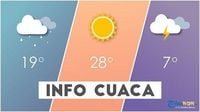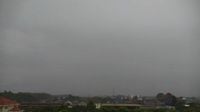On Friday, October 24, 2025, most major cities across Indonesia awoke to the sound of raindrops, as the country’s Meteorology, Climatology, and Geophysics Agency (BMKG) predicted widespread rainfall ranging from light showers to thunderstorms. With weather patterns shifting rapidly, residents from Sumatra to Papua were advised to keep umbrellas and raincoats handy, as the day’s forecast suggested little respite from the wet weather. The forecast, released early Friday morning, painted a detailed picture of the atmospheric conditions expected across Indonesia’s vast and varied archipelago.
According to BMKG forecaster Yohanes, as reported by Jakarta, the Sumatra region was set to experience mostly cloudy skies, with thick clouds hovering over Padang and light rain expected in Banda Aceh, Medan, and Tanjung Pinang. Pekanbaru, meanwhile, was singled out for the potential of thunderstorms. “Predicted thick clouds for Padang, light rain for Banda Aceh, Medan, and Tanjung Pinang, and be aware of the potential for thunderstorms in Pekanbaru,” Yohanes stated, emphasizing the need for vigilance in these areas.
Southern Sumatra was not spared either. Thick clouds were forecasted for Jambi and Palembang, with light rain likely in Bengkulu and Pangkal Pinang. Bandar Lampung faced a heightened risk, as BMKG warned of possible thunderstorms in the area. This pattern of unsettled weather extended across the islands, complicating travel plans and daily routines for millions.
Java, Indonesia’s most populous island, was also expected to see its share of precipitation. Light rain was forecast for Serang, Jakarta, and Surabaya, while moderate rain was on the cards for Bandung, Semarang, and Yogyakarta. The capital region, in particular, was bracing for a damp day. As detailed by KONTAN.CO.ID, the Jabodetabek area—which includes Jakarta, Bogor, Depok, Tangerang, and Bekasi—was expected to experience a mix of light to moderate rain throughout the day.
BMKG data showed that Jakarta Pusat would see light rain, with temperatures hovering between 25 and 30 degrees Celsius and humidity ranging from 69% to 95%. “The air in Central Jakarta today will tend to be more humid, especially in the morning and evening, which could lead to rain,” the BMKG report noted. Residents were encouraged to prepare for these conditions, particularly those planning outdoor activities. In Bogor and Tangerang, moderate rain was forecast, with temperatures ranging from 23 to 33 degrees Celsius and humidity levels frequently above 90%. Depok was expected to be hit by thunderstorms, while Bekasi would see light rain, both with similar temperature and humidity profiles.
Moving eastward, the islands of Bali and Nusa Tenggara were set for a mixed bag of weather. Kupang was predicted to enjoy partly cloudy skies, while Denpasar would see light rain. Mataram, however, was flagged for potential thunderstorms, underscoring the localized and sometimes unpredictable nature of Indonesia’s tropical climate.
Kalimantan, the Indonesian portion of Borneo, was forecast to have cloudy skies in Pontianak and light rain in Samarinda. But it was Tanjung Selor, Palangka Raya, and Banjarmasin that faced the risk of thunderstorms, with BMKG urging residents to stay alert for sudden changes in weather conditions.
The Sulawesi region, too, was not immune. As reported by BMKG Region IV Makassar and covered in Makassar, the morning in Makassar, Maros, and Gowa started off partly cloudy, but by afternoon and evening, light rain was expected. “The weather in Makassar, Maros, Gowa, and much of South Sulawesi is predicted to be partly cloudy in the morning, with light rain in the afternoon and evening,” the BMKG detailed. Moderate rain was anticipated for Toraja Utara and Luwu Utara, while Bulukumba and Kepulauan Selayar could expect cloudy conditions. Nighttime would bring more cloud cover, with light rain returning in the early hours across several districts.
BMKG’s forecast for South Sulawesi also included temperature and humidity details. Daytime temperatures were expected to range from 18 to 34 degrees Celsius, with humidity levels between 70% and 100%. Winds were predicted to blow from the north to east at speeds of 8 to 25 km/h, adding to the variability of the day’s weather.
Eastern Indonesia, including the provinces of Maluku and Papua, was forecast to see light rain in cities such as Ternate, Ambon, Sorong, Manokwari, Nabire, Jayawijaya, and Jayapura. Merauke, located in the far southeast, was flagged for moderate rainfall, which could impact local activities and transportation.
With such a broad swath of the country under rain clouds, BMKG’s message was clear: be prepared for wet weather, and remain vigilant for sudden shifts that could bring more severe conditions. The agency encouraged the public to check the latest updates on its official website or through the Info BMKG mobile application, as forecasts are updated hourly to reflect Indonesia’s rapidly changing weather patterns.
Yohanes, the BMKG forecaster, urged caution amid the potential for extreme weather events. “We urge the public to remain alert to the possibility of sudden extreme weather,” he advised, echoing the agency’s commitment to keeping citizens informed and safe.
For many Indonesians, these forecasts are more than just background noise—they’re essential guides for daily life. High humidity and fluctuating temperatures can affect everything from commute times to health, especially for those with respiratory conditions or outdoor jobs. The advice to carry an umbrella or raincoat was more than a courtesy; it was a practical necessity for navigating Indonesia’s rainy season.
Looking ahead, BMKG indicated that these patterns might persist for several days, as the wet season continues to assert itself across the archipelago. The agency’s detailed and region-specific forecasts enable communities to plan and adapt, whether for school, work, or leisure. As always, Indonesians are reminded to stay connected to official channels for the most accurate and up-to-date information.
With rain falling from Sumatra to Papua and everywhere in between, Indonesia’s diverse regions once again shared a common experience—one of adaptation, resilience, and, perhaps, a little inconvenience. But with timely information, preparation, and a dash of patience, life goes on, rain or shine.





